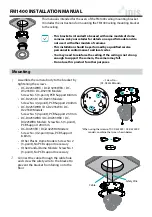
9(18)
Do not use the automatic locking of the locking pins at a height of over half a metre.
If the locking pins do not return to the normal position when the front plate is tilted, do
not raise the attachment any more. Lower the attachment on the ground and secure the
locking manually.
5.2.
Connecting and disconnecting hydraulic fittings
On 400 to 700 series loaders, the multiconnector type hydraulic coupling is used to connect hydraulic hoses.
If you want to change the type of the fittings on the loader or on the attachment, contact your Avant dealer or
service representative for instructions or installation service.
Never connect or disconnect quick couplings or other hydraulic components if the
system is under pressure, or if the control lever of the auxiliary hydraulics control lever
is locked on. Connecting or disconnecting the hydraulic couplings while the system is
pressurized may lead to unintended movements of the attachment, or ejection of high-
pressure fluid, which can cause serious burns or other injuries.
Connecting the multiconnector system:
Align the pins of the attachment connector with corresponding
holes of the loader connector. The multiconnector will not connect
if the attachment connector is upside down. Connect and lock the
multiconnector by turning the lever towards the loader.
The lever should move easily all the way to its locking position. If
the lever does not slide smoothly, check the alignment and position
of the connector and clean the connectors. Also shut down the
loader and release the residual hydraulic pressure.
To disconnect the multiconnector system, turn off the auxiliary
hydraulics of the loader, and unlock the multiconnector. To unlock,
push the knob on the side of the connector, and turn the lever to
disconnect.
Conventional quick couplings (alternative couplings for some loader models):
Before connecting or disconnecting the standard quick couplings, the residual pressure must be released as
shown below. The conventional quick couplings will not connect, if there is pressure in the hydraulic system.
To connect and disconnect the standard couplings, move the collar
at the end of the female fitting. The hoses should be connected so
that the fitting equipped with a coloured cap is connected to the
corresponding fitting of the loader. Note that the protective caps on
the loader and the attachment can be fastened to each other
during operation to reduce the accumulation of dirt. When
disconnecting the standard quick couplings a small amount of oil
may drip from the couplings. Wear protective gloves and have
some cloth at hand to keep the equipment clean.
Make sure that all three quick coupling fittings are properly connected, otherwise
the hydraulic motor of the attachment may get damaged.
Align the pins of the
multiconnector system
NOTICE
Conventional quick couplings
?
Summary of Contents for A411401
Page 17: ...Sand Salt Spreader 150 2014 1...
Page 18: ......



































